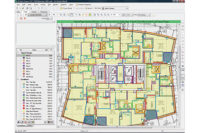Recently I had the pleasure of working with Norb Slowikowski, president of Slowikowski & Associates, on a webinar. Slowikowski has worked in the construction industry since 1982. He is a renowned productivity expert who has helped more than 300 contractors to improve their productivity to maximize their profitability. I invited Slowikowski to provide his expert insight on how contractors can get organized to increase their profitability. His full presentation can be found in the webinar series “Get Organized – Get Profitable.” Information on how to view the full webinars on-demand can be requested via the On Center Web site. The following are the highlights of Slowikowski’s profitability directives. This is the first in a two-part series on this topic.
THE INEXTRICABLE LINK BETWEEN PROFIT AND PRODUCTIVITY
Profit is a result, not an activity. It is not something you do; it is something you reach.
This is the first lesson that Slowikowski wants contractors to learn. “Profit isn’t something that is guaranteed from every project,” he points out. “Profit comes from a well-managed project. It’s what is recovered after all costs are paid. Profits are fragile, and many times contractors bid on jobs that ultimately only add three to five percent of profit to the bottom line.”
The journey to profitability begins with productivity. Unfortunately many construction industry contractors subscribe to the myths that productivity is out of their control, and that profitability is only figured after the project is complete. In fact, quite the opposite is true; productivity—or the lack of it—is in the hands of every contractor’s management team, and profitability is earned or lost with every step of a project.
“Ask yourself this simple question,” says Slowikowski. “Are my people working as productively as possible, day in and day out?” There are three components to productivity: the effective utilization of all resources which achieve a desired quality and a desired quantity of output. Let’s have a look at each of those components and what they mean.
Desired quality of output—every employee must perform his assigned tasks right the first time. In order to facilitate quality delivery, everyone must understand the scope of work and the quality specifications of the job. Companies simply cannot afford any rework.
Desired quantity of output—this comes down to meeting the general contractor’s schedule, which typically is very tight. The foremen must manage the resources effectively to meet that schedule. Labor can cost anywhere between 40 and 60 percent of a job. Therefore a subcontractor really has to manage its labor budget and give their foremen an accurate estimate of the hours for the job.
Effective utilization of resources—there are seven types of resources that are needed to support a productive environment. It’s up to the project manager to get the resources in place to support the project:
- Tools—workers must have the proper tools to do their jobs.
- Equipment—workers need the right equipment at the right time and know how to operate it safely.
- Materials—it’s essential to have the right materials at the right time with a secure and convenient place to store it at the job site.
- Manpower—every project needs the right amount of people who possess the right skills to get the job done.
- Information—the foremen must have all the information needed to run the job effectively and efficiently.
- Training/Coaching—there are some things that workers will need to learn on the job, and they need the right training or coaching from others to build their skills.
- Support—all workers need support from others when problems or conflicts arise.
When all of the components of productivity are in place, a contractor is much more likely to earn a healthy profit.
COSTS AFFECT PROFITABILITY TOO
A contractor can get the highest level of productivity from its crew but still make little profit if costs are not controlled. Recall that a profit is what is recovered after all costs are paid. There are several types of costs:

Cost of getting the business—a contractor has to spend money just to bring jobs in the door. This includes putting together marketing programs and materials to create awareness of what the company can do; having salesmen knock on doors and establishing relationships with general contractors; having engineers and estimators work up a design and bid a project; and so on. It’s possible to sink these costs and not even get the work.
Cost of delivering services to the customer—by far the largest category of cost for contractors, this bucket includes the purchasing department to buy materials and equipment; the manpower to deliver the services; the tools, material and other resources to do the job by the labor; and more.
Cost of operating and maintaining the contractor’s facilities—this is largely overhead costs such as office and warehouse space; utilities; maintenance and repairs for equipment; vehicles; insurance; support staff salaries; and the like. A portion of these costs is usually applied to each project the company works.
Cost of staying ready to work—a company must maintain its staff through training, certification and licensing; adhere to safety rules and regulations; and maintain information. These costs are actually investments back in the company.
ORGANIZATION IS KEY TO MAINTAINING PRODUCTIVITY AND CONTROLLING COSTS
Slowikowski defines the process of “organizing” as “systematically arranging all of the pieces of the work product through effective planning and coordination,” he says. “If a project is disorganized, this will diminish your profitability.” There are many steps that go into the organizing process and they all need to be followed. These steps include planning, prioritizing, scheduling, dividing work, delegating, performing, linking up and supporting, monitoring and following up, and problem solving. Let’s walk through the steps, one by one.
Planning—planning starts with the goal of where a contractor wants to be by a certain point in time. The foremen should be documenting (i.e., writing down, not keeping in his head) all the tasks that will be performed during the week with the goal of projecting where the project will be at the end of the week. The plan also should include what materials, equipment and labor are needed to complete the activities and the hours that are budgeted to get everything done.
- Prioritizing—it’s a fact of life that everything can’t be done at the same time. The foremen need to sequence the tasks of the plan in order of importance.
- Scheduling—the GC will provide a contractor with a macro schedule that outlines where the contractor should be working at certain times. From there the contractor’s foremen should be creating a rolling two-week plan that he regularly shares with the GC’s superintendent.
- Dividing Work—this steps involves breaking large tasks down into smaller, measurable tasks, each with a deadline of when it must be completed. When the foremen sees the project divided into a series of individual tasks, it’s easier to understand when something is off-schedule and to work to get it back on track.
- Delegating—now it’s time to assign work duties to people, ensuring that they understand what is expected of them for quality work and adherence to standards.
- Performing—action is everything. Now it’s time for everyone to be moving forward toward the same goal with the intention that nothing will need to be reworked due to poor quality or failure to meet standards.
- Linking Up and Supporting—teamwork is critical to succeed in this game. There are worker interdependencies and everyone, including field and office personnel, must be supportive of each other.
- Monitoring and Following Up—this step involves verifying that work has been done and done properly.
- Problem Solving—big or small, problems arise all the time and the contractor must be prepared for continuous problem solving to keep the project on track.
The contractor that can keep a project organized through all of these steps is well-equipped to make a healthy profit.
ALL IN ALL
In summary, there are several practices that will help a contractor to get organized, improve productivity and increase the likelihood of earning a respectable profit:
From the front office to the field, people need good information. They need to know what to do, when to do it and how to do it.
The entire team needs to be organized and on the same page. Everyone needs to be operating from the same playbook and supporting each other.
The foremen need to ensure that the team uses its resources wisely and is mindful of costs that can quickly eat into profits.
In part two of this piece, I will discuss the role technology plays in both getting organized and improving productivity and protecting profits. For more information on this topic, please request links to watch the on-demand webinars, “Get Organized – Get Profitable, Part 1” and “Get Organized – Get Profitable, Part 2” featuring Slowikowski and the author of this column.





Report Abusive Comment